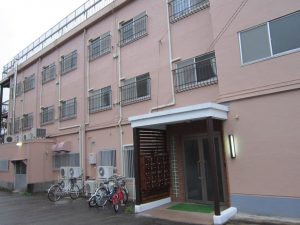Caitlin MEAGHER
Wentworth Institute of Technology, Boston
meagherc[@]wit.edu
At this year’s annual meeting, I presented a paper entitled ‘Rethinking community?: alternative housing as a response to alienation in contemporary Japan’ adapted from the final chapter of my doctoral thesis. The paper emerged out of the apparent gap between the rhetorical uses of ‘community’ in contemporary sharehouse marketing discourses and the exclusivity I observed during fieldwork, specifically with regard to renting rooms to older Japanese. In the paper I presented (and at greater length and detail in the chapter from which it is excerpted), I discussed the way ‘community’ and related tropes like kizuna (human bonds) and mura shakai (village society) become marketing slogans aimed at an audience of young consumers suffering the anxiety of literal and physical displacement.

Initially, I was struck by the way marketing literature re-worked these evocative metaphors for rootedness and stability into a discursive medium that emphasizes individual freedom, mobility, and – perhaps above all – emancipation from traditional social roles, in a bid to attract young unmarried residents. Among the most frequently appearing tropes is kizuna which, as Anne Allison tidily puts it, ‘became the new buzzword [following the 3/11 disaster]: belonging to one another, to Japan, to a homeland transformed by mud and radiation. References to connectedness (tsunagari) and bonds (kizuna) gushed everywhere…’ (2013, p.198). (Indeed, Pilvi Posio and Giulia Cavicchioli De Togni also presented papers, both of which I thoroughly enjoyed, on the topic at this year’s meeting).
I discussed the way that the kizuna invoked in sharehouse marketing literature is conspicuously limited in its meaning: kizuna implies the benefits of being supported, without the obligation of supporting others. In a similar way, the references to mura shakai are metaphorical, and reference 20th century economic stability and widespread middle-classness, rather than the pre-modern agrarian village. References to the sharehouse as a return to village-like social belonging are qualified as ‘neo-mura shakai’ or ‘21 seiki mura shakai’, to indicate its compatibility with contemporary social and economic conditions – as temporary, provisional, and elective.

Thus, although sharehouse marketers often advance the idea that wide-scale adoption of sharehouse living will reap social benefits for a changing Japan (Kubota 2009; Miura 2011, 2014), in practice, membership is limited to the young and, in many cases (as when landlords enforce an age limit) only while they remain young. The largest and fastest-growing group of single-person households is older women (MHLW 2018), a vulnerable population who, in theory, would benefit most from participating in shared housing (though, as our gracious host has demonstrated in her work [Platz 2011], older Japanese remain ambivalent about shared housing). In any case, due to its inbuilt exclusivity, the sharehouse’s promise of ‘social benefits for Japan’s future’ is, at best, overstated.[1] The ‘community’ promised by the sharehouse is characterised by the same exclusionary logic as earlier forms based on employment and/or local residence, merely with different criteria for membership and anticipated length of tenure. It reinforces the anthropological truism that there can be no ‘us’ without ‘not-us’.
Inside a Japanese sharehouse: dreams and realities
‘Community’ is one among the themes of continuity and change in my doctoral research, which will join the Routledge JAWS series in 2020. The book will focus on the sharehouse as a site of conflict and negotiation between housemates, but also between independence and a need for social belonging; cosmopolitanism and ‘Japaneseness’; innovation and embedded cultural habits; aspirations and realities.

The book is based on intensive fieldwork in a mixed-sex sharehouse in Osaka Prefecture. As it happened, I was one of the first tenants to move into the 28-room house. By virtue of this unexpected circumstance, I was able to observe housemates’ initial resistance to, and eventual demand for, clear protocols and social roles within the house. Throughout data collection and analysis, I compared my housemates’ practices against their own life narratives and against popular and scholarly discourses about sharehouses. The discrepancies between these discourses and observed practices are at the core of this research.
One central theme, or cluster of themes, concerns the changing role of young women in late Heisei Japan. I was surprised that the majority of housemates were young women, most working in the culture industries; on further analysis, as I argue in the book, sharehouse marketing targets these young women on the basis that the sharehouse, unlike the traditional workplace or family home, provides a testing ground for interpersonal skills and independence. As a result, women are overrepresented in sharehouse residence nationwide by approximately two to one (Hitsuji, 2013). Several chapters consider the various implications of this fact, especially with regard to the way male and female housemates retain, reject, or revise traditional gender and domestic norms. In broad terms, I found while that popular discourses surrounding the sharehouse tend to emphasize themes of individual emancipation and social experimentation, in practice, housemates inevitably imported familiar conventions into this space. Change is improvised, contested, and incremental.
References
ALLISON, A. 2013. Precarious Japan. Durham, NC: Duke University Press.
HITSUJI REAL ESTATE. 2013. 100,000 Thanks Report. Available online: http://www.hituji.jp/comret/survey/20130418-100000-thanks-report and http://www.toto.co.jp/tsushin/2014_newyear/pdf/feature1_2.pdf accessed 29th May 2019.
KOYABE, I. 1997. Korekutibu Hauzingu no susume (Recommendations for ‘collective housing). Tokyo: Maruzen.
———2012. Daisan no Sumai: Korekutibu Hauzingu no subete (The Third Life: all about ‘collective housing’). Tokyo: X Knowledge.
KOYABE, I, IWAMURA, K., UTSUKI, M., ENDŌ, Y., AND NAKAMURA, Y., (eds.) 1997. Kyō ni Sumu Katachi (forms of living together). Dōyōbi Kenchiku Gakō 4 (Saturday architecture school series #4). Tokyo: Kenchiku Shiryo Kenkyusha Co., Ltd.
KUBOTA, H. 2009. Tanin to Kurasu Wakamonotachi (Young People Who Live with Others). Tokyo: Shueisha.
METI (Ministry of Economy, Trade, and Industry). 2016. Heisei 27 Nendō kigyō/bencha-shien ni Kansuru chōsa – kigyōka seishin ni kansuru chōsa (Fiscal Year 2015 survey on entrepreneurship and venture capital/survey on entrepreneurs’ attitudes). Available online: https://www.meti.go.jp/meti_lib/report/2016fy/000285.pdf, accessed 29th May 2019.
MHLW (Ministry of Health, Labour, and Welfare). 2018. Gurafu de miru settai no jōkyō (Graphical Review of Japanese Household) 2016. Available online: https://www.mhlw.go.jp/toukei/list/dl/20-21-h28.pdf, accessed 29th May 2019.
MIURA, A. 2011. Korekara No Nihon No Tame Ni ‘Shea’ No Hanashi Wo Shiō (For the Future of Japan, Let’s Talk about ‘Sharing’). Tokyo: NHK Shuppan.
———2014. The Rise of Sharing: Fourth-Stage Consumer Society in Japan. Tokyo: LTCB Library Trust/International House of Japan.
PLATZ, A. 2010. ‘Living Apart Together: Anticipated home, family, and social networks in old age’. In RONALD, R. and ALEXY, A. (eds.). Home and Family in Japan: Continuity and Transformation. London: Routledge, pp. 254-269.
[1] In fact, the choice of the katakanised ‘sharehouse’ was intentional, to differentiate the sharehouse from the more intensive sharing and age-inclusivity of kōkyō jūtaku or ‘collective housing’, based on Scandinavian models for social housing, advocated by architects like Koyabe Ikuko since the late 1990s (Koyabe 1997, 2012; Koyabe et. al. (eds.), 1997).
